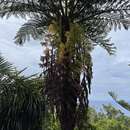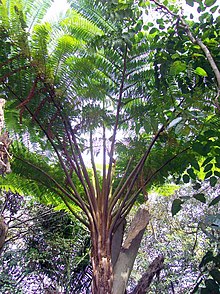pt-BR
nomes no trilho de navegação


Der Norfolk-Baumfarn (Cyathea brownii) gilt als der größte aller Baumfarne der Welt. Er stammt von der Norfolk-Insel und erreicht dort Höhen von bis zu 30 m. Die langen und breiten doppelt- bis dreifach gefiederten Wedel können Längen bis zu 5 m erreichen. Der Stamm ist lang und wie die jungen Wedel stark von braunen bis orangefarbigen Haaren bedeckt; er kann mit der Zeit glatt werden und ovale Narben von abgefallenen Wedeln aufweisen. Cyathea brownii ist nach dem Botaniker Robert Brown (1773–1858) benannt.
Der Norfolk-Baumfarn wächst aus Sporen heran, als Jungpflanze recht schnell, bis zu 30 cm pro Jahr und bildet dabei ungefähr einen Wedel pro Monat. Er benötigt dazu einen neutralen bis leicht sauren humusreichen Boden; dieser muss feucht, aber leicht durchlässig sein. Staunässe verträgt die Pflanze schlecht. Cyathea brownii benötigt außerdem eine hohe Luftfeuchte sowie mäßig bis viel Wasser und liebt einen hellen Standort ohne Mittagssonne. Dünger wird kaum benötigt, es besteht eher die Gefahr der Überdüngung, wodurch die Pflanze starke Schäden erleiden kann. Der Norfolk-Baumfarn kann leichte Fröste bis −4 °C gut vertragen, sollte aber doch vor stärkerem Frost geschützt werden. In kälteren Regionen wird diese schöne und außergewöhnliche Pflanze meist im Gewächshaus gehalten. Sie ist einfach zu handhaben und erholt sich durch ihr schnelles Wachstum auch gewöhnlich rasch von Schäden. Seine Größe kann den Baumfarn allerdings auch recht unpraktisch machen.
Cyathea brownii ist im subtropischen Regenwald der Norfolk-Insel zu Hause. Die Tagestemperaturen liegen bei ca. 23 °C in den Sommermonaten und ca. 17 °C im Winter; die Höchsttemperaturen liegen ca. bei 29 °C, die niedrigsten bei 6 °C. Die relative Luftfeuchte beträgt gleich bleibend zwischen 70 und 80 Prozent das ganze Jahr über; der Jahresniederschlag ca. 1200 mm.
Der Norfolk-Baumfarn (Cyathea brownii) gilt als der größte aller Baumfarne der Welt. Er stammt von der Norfolk-Insel und erreicht dort Höhen von bis zu 30 m. Die langen und breiten doppelt- bis dreifach gefiederten Wedel können Längen bis zu 5 m erreichen. Der Stamm ist lang und wie die jungen Wedel stark von braunen bis orangefarbigen Haaren bedeckt; er kann mit der Zeit glatt werden und ovale Narben von abgefallenen Wedeln aufweisen. Cyathea brownii ist nach dem Botaniker Robert Brown (1773–1858) benannt.
தாவரவியல் பெயர்:அல்சோபைலா எக்செல்லா (Alsophila excelsa)
குடும்பம்: டிக்சோனியேசியீ (Dicksoniaceae)
மலர் எனும் உறுப்புத் தோன்றாத பூவாத்தாவரம் ஆகும். பெரணிகளில் 280 சாதிகளும், 10,000 மேற்பட்ட இனங்களும் உண்டு. பெரும்பாலும் சிறு செடிகளே. இவைகளில் சிலவே மரமாக வளர்கின்றன. பெரணிகளிலே முதன் முதலில் வேர், தண்டு, இலை என்கிற உண்மையான வேறுபாடுகள் காணப்படுகின்றது. இவைகளின் வேர்கள் சாதாரண தாவரங்களின் வேரைப்போல இல்லாமல் ஒட்டுவேர்கள் கொண்டுள்ளது.
பெரணிகளில் சையாத்தியா, ஆல்சோபைலா ஆகிய சாதிகளில் சில இனங்கள் மட்டுமே மரமாக வளர்கிறது. அல்சோபைலா எக்செல்சா பெரணி 60-80 அடி உயரம் வளரக்கூடியது. பார்ப்பதற்கு மரம் இருக்கும். இலைகள் மிக விளக்கமாவும், மிக அழகாகவும் இருக்கும். ஒவ்வொரு இலையும் 4மீ நீளம் கூட இருக்கும். இலை முழு முதிர்ச்சி பெறுவதற்கு இரண்டு மூன்று ஆண்டுகள் கூட ஆகும். பெரணி இலைகளின் தளிர்கள் வில்போன்ற சுருள் வடிவில் மடிக்கப்பட்டிருக்கும். இலை வளர வளர சுருள் மெல்ல மெல்ல விரிந்து கொண்டே போகும். இலைகளின் அடியில் ஸ்போர்கள் எனும் விதைத்துகள் உண்டாகின்றன. இம்மரம் ஆஸ்திரேலியாவில் வளர்கின்றன. அல்சோபைலா என்பது கிரேக்க பெயர் ஆகும்.
| 1 || சிறியதும் - பெரியதும் [1] || அறிவியல் வெளியீடு || ஜூன் 2001
Sphaeropteris excelsa, synonym Cyathea brownii,[2] commonly known as the Norfolk tree fern or smooth tree fern, is probably the largest fern species in the world. It is endemic to Norfolk Island, in the Pacific Ocean near Australia and New Zealand. It is named after the botanist Robert Brown (1773-1858).
In its natural habitat, Sphaeropteris excelsa is reported to reach 20 metres (66 ft) or more in height.[3] The broad, lance shaped, bipinnate-pinnatifid to tripinnate fronds can reach 5 metres (16 ft)) in length. Stipe is long and has a line of white, stitch like dashes along its length. Rachis and stipe are covered in white-brown and darker orange-brown scales. The trunk can become smooth with age and may display oval scars left from fallen fronds.[4]
Sphaeropteris excelsa occurs naturally in subtropical rainforests on Norfolk Island. Average daytime temperatures reach around 23 °C (73 °F) during the summer months falling to around 17 °C (63 °F) during the winter. The highest temperatures likely to be experienced in this environment are around 29 °C (84 °F), the lowest around 6 °C. Relative humidity is fairly consistent at levels between 70 and 80% throughout the year. Yearly rainfall is approximately 1,200 millimetres (47 in).
The once extensive forests of Norfolk Island are now reduced to a single small forested area which has been designated part of a national park. Sphaeropteris excelsa is protected within this park. It is available in cultivation in many countries and though rare is not considered endangered.[5]
Sphaeropteris excelsa is cultivated as an ornamental tree. It requires a neutral to slightly acidic soil[6] rich in organic matter. The soil must be moisture retentive but well drained.[5] The tree fern will suffer if left to stand in waterlogged soil. Sphaeropteris excelsa requires high humidity and either high rainfall or frequent watering. During the summer months even a very young pot grown plant can consume 0.5 litres (0.13 US gal) of water per day.
Sphaeropteris excelsa requires good light but does best when shaded during the hottest parts of the day. It responds well to fertilization but can be intolerant of some commercial fertilizers producing malformed fronds and a larger but weaker plant. It is able to withstand only light frosts. Larger plants may survive overnight temperatures as low as minus three degrees Celsius.
In countries such as Britain it is best grown in a conservatory. Its large size however often makes this impractical. A beautiful and rewarding plant but in colder regions it is strictly for the more dedicated of enthusiasts.
It is easily grown from spore and can be very fast growing when young.
Sphaeropteris excelsa, synonym Cyathea brownii, commonly known as the Norfolk tree fern or smooth tree fern, is probably the largest fern species in the world. It is endemic to Norfolk Island, in the Pacific Ocean near Australia and New Zealand. It is named after the botanist Robert Brown (1773-1858).
Sphaeropteris excelsa (R.Br. ex Endl.) R.M.Tryon, sinonimo Cyathea brownii, conosciuta in inglese come "smooth tree fern", è probabilmente la più grande felce al mondo, della famiglia delle Cyatheaceae. È endemica dell'isola di Norfolk.
Michael Hassler e Bernd Schmitt, Sphaeropteris excelsa, in Checklist of Ferns and Lycophytes of the World, vol. 8, n. 2, giugno 2019. URL consultato il 23 agosto 2019.

Sphaeropteris excelsa (R.Br. ex Endl.) R.M.Tryon, sinonimo Cyathea brownii, conosciuta in inglese come "smooth tree fern", è probabilmente la più grande felce al mondo, della famiglia delle Cyatheaceae. È endemica dell'isola di Norfolk.
Sphaeropteris excelsa là một loài dương xỉ trong họ Cyatheaceae. Loài này được R.M.Tryon mô tả khoa học đầu tiên năm 1970.[1] Danh pháp khoa học của loài này chưa được làm sáng tỏ.
Sphaeropteris excelsa là một loài dương xỉ trong họ Cyatheaceae. Loài này được R.M.Tryon mô tả khoa học đầu tiên năm 1970. Danh pháp khoa học của loài này chưa được làm sáng tỏ.